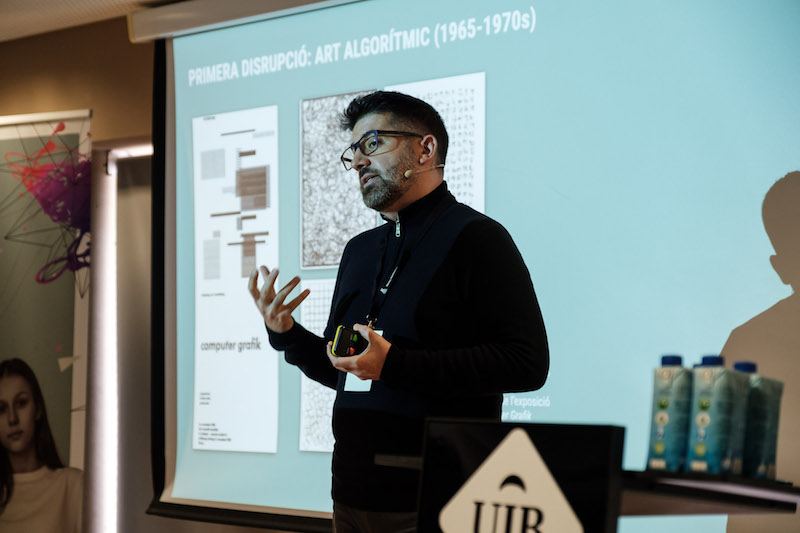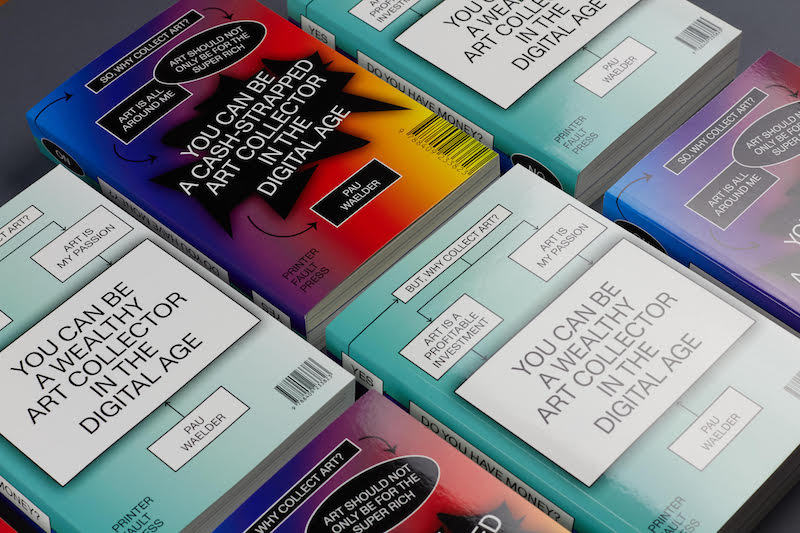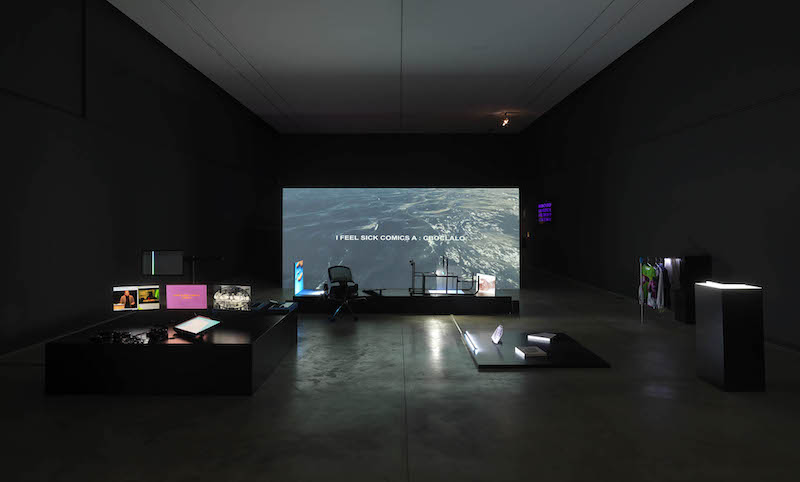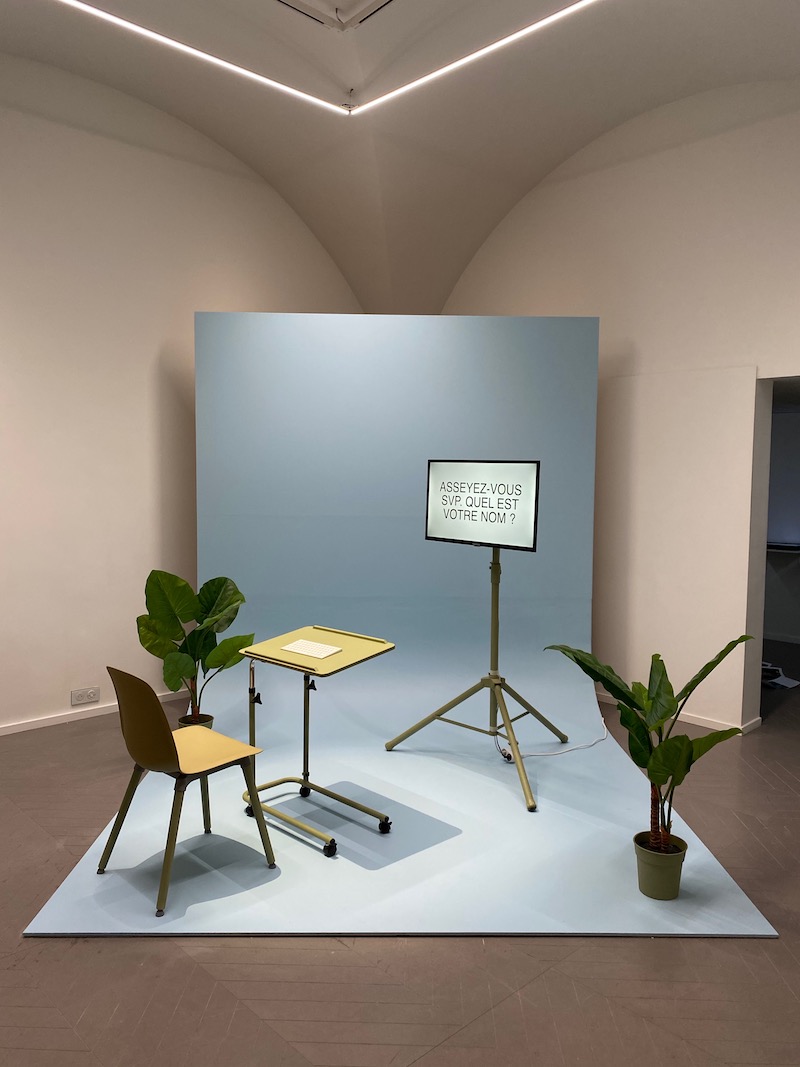by Rebecca Partridge // Feb. 11, 2022
It’s impossible to discuss digital and new media art today without acknowledging the recent appearance of the NFT. Initially, these non-fungible digital records seemed to offer artists working with digital technology an alternative way to sell their work, while challenging established art world hierarchies. However, as artists and the market get to grips with this new trading technology, it is revealing the contradictions inherent within digital art, playing out perennial problems around making, experiencing and selling artworks. Why are we still talking about NFTs? It’s a question addressed by curator and researcher Pau Waelder, who has been writing and researching art and digital media for over a decade. He has recently written extensively on NFTs and the art market, as well as curated a number of international exhibitions of new media art that explore process, interaction and virtuality. We spoke between London and Palma to unpack some of the current complexities of working in digital arts.

Pau Waelder, portrait // Courtesy of Pau Waelder
Rebecca Partridge: New media art and NFTs are often discussed under the umbrella of “digital” but the relationship between the two appears to be complex, which is something I’d like to discuss. To begin, could you introduce us to NFTs and how they came about?
Pau Waelder: NFTs are basically a register on a blockchain. It’s like a certificate of authenticity, stored in a distributed ledger that is publicly accessible and tamper-proof. Blockchain was built to store records of Bitcoin transactions, but it has shown to have other uses that are currently exploited in the art market. A problem that many digital artists have had for decades is: if their work is infinitely reproducible, how do you provide a certificate of authenticity and proof of its ownership? Since around 2014, digital art has been sold by sending the file to the buyer and handing them a record of the transaction on blockchain. Then came the idea of the non-fungible token: here, instead of registering a transaction, you create a unique token, that unlike cryptocurrencies, cannot be swapped by another token of the same value, or divided. This token is linked to a file (an image, video, text file, software, for example) that’s stored somewhere else. So whoever owns the token is the rightful owner of the file, regardless of whether other people have access or download it. Digital art can therefore be sold as a file linked to a unique token. This token serves as proof of ownership, and, because it is a unique piece of data, it can be easily sold and traded.

Pau Waelder: ‘YOU CAN BE A WEALTHY / CASH-STRAPPED ART COLLECTOR IN THE DIGITAL AGE,’ Printer Fault Press, 2020
RP: What’s fascinating is that this came out of nowhere for much of the art world and what really took people by surprise is that the artworks being sold for crazy prices were by artists we’d never heard of! They hadn’t emerged from within the established contemporary art world. Was it just these original first time pieces that have reached those prices?
PW: There’s two things. The growing momentum for NFTs emerged within a particular environment, which was not art, but collectibles, such as crypto kitties or crypto punks. Around 2018/19, the two most powerful auction houses—Christie’s and Sotheby’s—started to notice a growing trend among cryptocurrency investors buying NFTs. This was interesting to them because it opened a potentially profitable market niche that’s much more dynamic than the traditional secondary market. Christie’s and Sotheby’s had already tested the waters selling digital art with a couple of auctions of artworks created with Artificial Intelligence that grabbed the attention of the media, but were not particularly spectacular. At that time, selling digital art introduced the possibility of auctioning work that was not known to contemporary art collectors, nor sanctioned by other major players (such as art galleries, art fairs or influential collectors) but that could be sold at a high price on the basis of the novelty of its production and on apparently being a historical “first.”
RP: But you can only sell these historical moments once, can’t you?
PW: Unless you start looking for other firsts, which is what they did. In 2020, Christie’s tried a different direction with Block 21 by Robert Alice. It was a physical artwork that also had an NFT. That was like the first draft. But, with Beeple, they really did the big sale, reaching a mind-blowing price that shook the whole art market. So the current NFT market can be seen as the confluence of this trend of crypto investors buying collectibles, the auction houses looking for a new market, and then suddenly this big sale of someone whom no one knows in the art market, selling for several times the amount of great masters. Beeple’s sale makes no sense in the traditional art market, but it happening suggested that a new, very profitable market was just opening. I’m not at all convinced by this particular sale nor the quality of the work.
In the end, the most interesting thing isn’t Beeple, but what happened afterwards—many illustrators, designers and visual artists are able to use a 3D modeling app and create images and animations. So, that opened a frenzy of selling on the already existing NFT marketplaces, with some boldly pricing their works in the tens or hundreds of thousands, or even millions of dollars. In the midst of all this, artists and galleries and curators who had been working with digital art for decades were trying to figure out what the hell is going on. Some started creating marketplaces to sell NFTs, telling crypto investors they should buy from professional artists, who have a trajectory and are already committed to digital art. So this is how the market has evolved over the last year, with some marketplaces offering a curated selection based on quality and professional record, and others just opening up to anyone who wants to sell.

Grégory Chatonsky: ‘Capture: Submersion,’ 2016, installation shot ‘Real Time. Art en temps real’, Arts Santa Mònica, Barcelona, 2016 // Photo by Gasull
RP: The work that we’re seeing of these NFT artists is still tied to an image, or a GIF. So ironically you could make an NFT of any artwork in a gallery’s roster, but perhaps the most difficult thing to make an NFT of is interactive or durational New Media Art, which is fundamentally counter to the traditional static image or object?
PW: That is something that artists working with generative or interactive art are testing. When you upload an NFT, you’re uploading a file to a shared server and the register then links to that file, so if it’s just a video or an image, that’s okay. But if it’s a program that has to run, then you can start to have problems. I’ve seen most of the more experimental NFTS in a marketplace called Hic et Nunc, a community that started in March last year, and quickly gathered a lot of artists. Most of the marketplaces are in the Ethereum blockchain (where most investors are) but minting an NFT there is more expensive. Hic et Nunc was launched in the Tezos blockchain, which is a different cryptocurrency, less popular and thus cheaper. The lower prices made it easier for artists to enter and to experiment, because there was not much to lose. That’s created a very interesting community that’s developed over this last year, of artists, creating, experimenting and sharing, with most of them selling for very low prices. In fall last year, the founder of Hic et Nunc closed the marketplace, but immediately the community reacted, creating mirror sites and other similar marketplaces. This means that the Tezos community is not going away, and will remain as an alternative for artists.
RP: One of the ideas that was originally exciting about cryptocurrencies was decentralisation, or global currency. Similarly, it seemed like NFTs offered a way of decentralising the art world or breaking down its hierarchy: there’s transparency, a record of sale and prices, ways of bypassing galleries. But as it plays out, what’s apparently been recreated is a mirror of the hierarchies that we struggle with in the established art world. If it’s also problematic for process driven work, then am I right in saying much of what it appeared to offer digital arts in the beginning hasn’t come to pass?
PW: I think that decentralisation is a myth. If you decentralise something you create different nodes, each will be a centre of a different community. I do believe it’s been liberating for artists to be able to create an NFT and to sell it directly, but it ends up replicating the structures that we already know. The other thing is the format, which is really interesting… As you said, we are constantly going to traditional formats, things that look like painting or video. The Beeple collage is just that. It’s a very big collage. NFT images typically use rich visual imagery, that partly due to Beeple tends to dwell in the context of sci-fi and cyberpunk. There are lots of imitators of every successful trend that comes out. The market is currently very competitive, with all these images trying to stand out in online marketplaces, which are basically a grid on a webpage. That’s why most NFTs are square, because that’s the way to show your artwork inside this grid.

Lauren Lee McCarthy: ‘Autocomplete,’ 2020 in ‘Selphish,’ Mécènes du sud Montpellier-Sète, exhibition view // Courtesy of Pau Waelder
RP: Which makes it even more reductive! Thinking about ways that digital technologies are being used by artists to create works that take us much further, I’d like to talk about your curatorial practice. ‘Real Time. Art en temps real’ (Arts Santa Mònica, Barcelona) considered the relativity of time and our perception of it, and many of the works were durational or drew on live data. ‘Selphish. L’exposition de soi’ (Mécènes du Sud, Montpellier, co-curated with Thierry Fournier) considered questions of identity, with work generated through interactivity. Both exhibitions reveal some of the larger and more nuanced ideas that are being explored through new media. Can you say something about what you find most interesting that is happening in contemporary digital arts?
PW: I’m currently teaching this as an online course at Node, titled ‘Curating New Media. Process, Interaction, Virtuality.’ These three concepts are what I think are most interesting about new media art. On one hand, my curation has tried to bring digital art to people and make them understand that this is contemporary art, there is a concept behind it and a particular kind of experience. On the other, I try to communicate that these artworks are reflecting on issues related to technology that are relevant to us all; what is real time, what is intimacy, what is identity, these kind of things. I’m interested in artists working with process-based artworks or interactive artworks, in different formats that create different kinds of experiences. With the exhibition, ‘Selphish,’ Thierry and I really intended to turn the relationship that the audience has with the artwork upside down, by making the audience part of the artwork, inviting people who generously let us use their social media accounts to feed the content of a series of artworks. I think it’s really exciting to be able to try out different things, while understanding it as art. There has to be content behind it.
RP: Would you agree that there’s an extra pressure on new media artists in the sense that technology evolves so quickly, if the content of the artwork doesn’t transcend its medium, then it’s lost? Whereas for a painter or sculptor, the language is so established they don’t have to worry about that.
PW: Exactly. When you’re a painter, you have centuries of the medium behind you, which is also a great thing about it. Every time an artist has an intention to put something on a canvas, they can work on the basis that what they do is already art. For artists working with digital media, there has been the struggle to be accepted as artists, but also the double-edged attraction of novelty. Nowadays, NFTs are riding the wave of novelty and a hyped-up market. So, in some cases, you might have a cool image that means a lot in 2021, but most probably by 2023 people will have moved on to something else, and that NFT you bought may be worthless. Or maybe it was worth it for the time you used it. We’re entering a more ephemeral state of things where people don’t care so much about keeping things forever. This is also a trend among some younger collectors, who don’t conceive of their art collection as something to keep for their whole life, and then pass on to their kids. It’s just for that moment. NFTs just made this kind of collecting easier and faster. Ultimately, I think that’s also a good lesson for everyone in the art world, to think beyond what we know and what we think is right. Because our society, the art world and the art market are changing very rapidly, and one needs to adapt and understand what is going on.
This article is part of our feature topic of ‘Digital.’ To read more from this topic, click here.






















